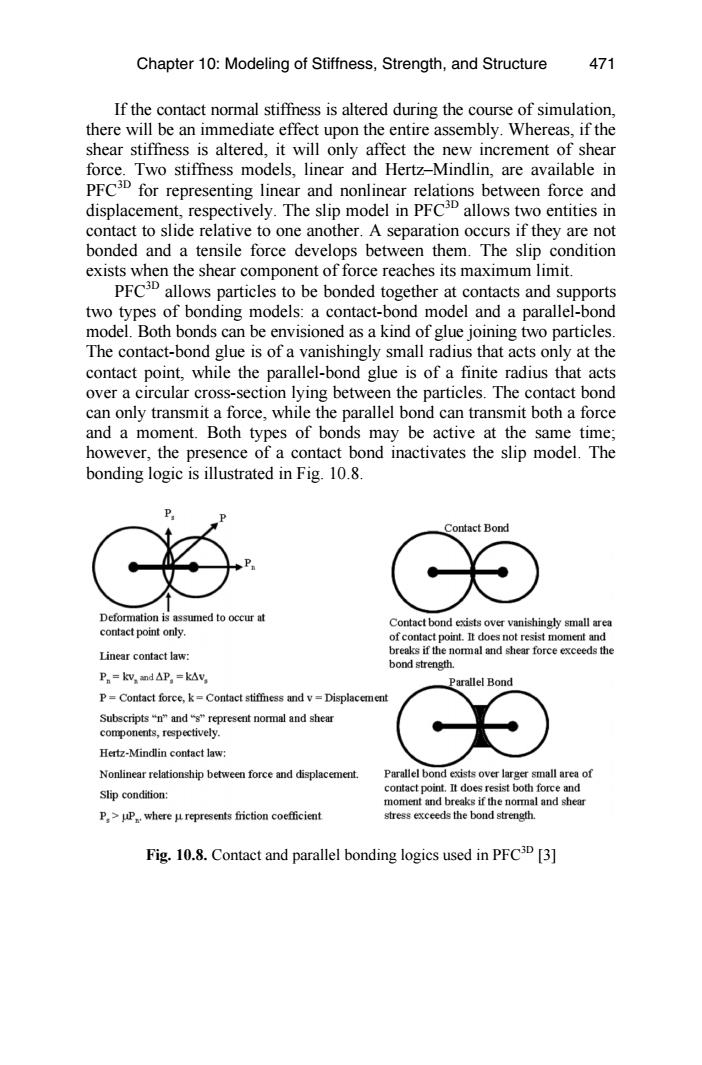正在加载图片...

Chapter 10:Modeling of Stiffness,Strength,and Structure 471 If the contact normal stiffness is altered during the course of simulation, there will be an immediate effect upon the entire assembly.Whereas,if the shear stiffness is altered,it will only affect the new increment of shear force.Two stiffness models,linear and Hertz-Mindlin,are available in PFC3D for representing linear and nonlinear relations between force and displacement,respectively.The slip model in PFC3D allows two entities in contact to slide relative to one another.A separation occurs if they are not bonded and a tensile force develops between them.The slip condition exists when the shear component of force reaches its maximum limit PFC3D allows particles to be bonded together at contacts and supports two types of bonding models:a contact-bond model and a parallel-bond model.Both bonds can be envisioned as a kind of glue joining two particles. The contact-bond glue is of a vanishingly small radius that acts only at the contact point,while the parallel-bond glue is of a finite radius that acts over a circular cross-section lying between the particles.The contact bond can only transmit a force,while the parallel bond can transmit both a force and a moment.Both types of bonds may be active at the same time; however,the presence of a contact bond inactivates the slip model.The bonding logic is illustrated in Fig.10.8. Contact Bond Deformation is assumed to occur at Contact bond exists over vanishingly small area contact point only. of contact point.It does not resist moment and Linear contact law: breaks if the nommal and shear force exceeds the bond strength. Pn=kv,and AP,=kAv, Parallel Bond P=Contact force,k=Contact stiffness and v=Displacement Subscripts"n”and“s"represent normal and shear components,respectively. Hertz-Mindlin contact law: Nonlinear relationship between force and displacement Parallel bond exists over larger small area of Slip condition: contact point.It does resist both force and moment and breaks if the normal and shear P.>uP.where represents friction coefficient stress exceeds the bond strength Fig.10.8.Contact and parallel bonding logics used in PFC3 [3]If the contact normal stiffness is altered during the course of simulation, there will be an immediate effect upon the entire assembly. Whereas, if the shear stiffness is altered, it will only affect the new increment of shear force. Two stiffness models, linear and Hertz–Mindlin, are available in PFC3D for representing linear and nonlinear relations between force and displacement, respectively. The slip model in PFC3D allows two entities in contact to slide relative to one another. A separation occurs if they are not bonded and a tensile force develops between them. The slip condition exists when the shear component of force reaches its maximum limit. PFC3D allows particles to be bonded together at contacts and supports two types of bonding models: a contact-bond model and a parallel-bond model. Both bonds can be envisioned as a kind of glue joining two particles. The contact-bond glue is of a vanishingly small radius that acts only at the contact point, while the parallel-bond glue is of a finite radius that acts over a circular cross-section lying between the particles. The contact bond can only transmit a force, while the parallel bond can transmit both a force and a moment. Both types of bonds may be active at the same time; however, the presence of a contact bond inactivates the slip model. The bonding logic is illustrated in Fig. 10.8. Fig. 10.8. Contact and parallel bonding logics used in PFC3D [3] Chapter 10: Modeling of Stiffness, Strength, and Structure 471